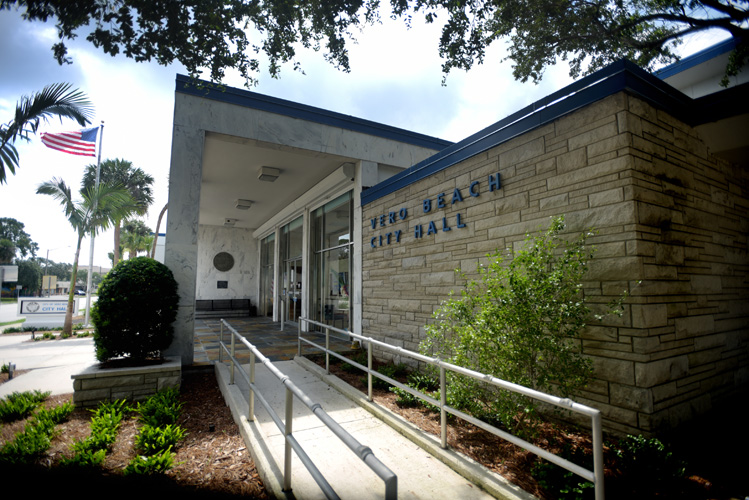
Buckets sit on the floor around the upstairs portion of Vero Beach City Hall to catch water from recent downpours, punctuating the dire need for a new roof.
Not to worry. Vero has $1 million of your money in reserve that’s budgeted for the job. The big question is, will the city put a new roof on the 58-year-old building, or decide to build a new City Hall instead on the part of the Centennial Place site known as the “Old Postal Annex?”
The Old Postal Annex site occupies the southwest corner of 17th Street and Indian River Boulevard and the city already owns the land. The idea of moving City Hall to that site near the riverfront came up last July, but it got dropped as the focus turned to coming up with a central vision for redeveloping the electric and sewer plant properties.
“City Manager Monte Falls agreed to research whether Centennial Place could be an appropriate location for a new City Hall,” a July 25, 2019 report in Vero Beach 32963 stated.
Nearly a year later, the council is right back to square one, with a leaky roof and no viable alternative to fixing it. As for the idea of moving City Hall, “I don’t think that got a lot of traction that I heard,” Falls said.
But he told the council again last week that he would look into it, talk to an architect who could give them a ballpark figure of how much a new City Hall might cost, and get back to them.
The existing 42,000-square-foot City Hall was expanded and remodeled over the years to accommodate a growing city staff. But in the years after the Great Recession, budget hawks on the city council trimmed the payroll and cut city staff. The sale of the electric utility further reduced the need for city workers.
Falls said the number of employees is down about 33 percent from its peak during the mid-2000s. That means a lot of empty offices and inefficiently allocated space.
Councilman Rey Neville said he would like a professional to look at how the city could make better use of the space it has and re-imagine it to serve the public better. “Anybody who has ever walked around in this building, I wonder how you’d ever find your way out?” Neville said.
Neville suggested the city could sell the Old Postal Annex parcel and use those funds to remodel City Hall. Or if the decision was made to construct a new building near the river, it could sell the existing city hall property to help fund a new facility.
Vice Mayor Laura Moss said designing a new city hall as part of Centennial Place might help residents feel closer to their city government, and thus increase public participation.
Moss said she is not suggesting the move, but that if it does take place, a new City Hall could be “not just for the government,” but a multipurpose space for use by the public as well as city employees.
“You can have concerts there; you can have an art show there. You can have all kinds of activities there so that, if this were to happen, I think it would be a great way to do things,” Moss said. “One of the things I’ve tried to do for years now is to encourage more people to participate in the process – and earlier in the process.”
Building a new City Hall might be a great idea, but the precarious location of the Old Postal Annex site could leave city officials longing for the days when buckets of water from leaky roofs was the biggest moisture problem.
That area of the city along the Indian River Lagoon, and the surrounding residential neighborhood called Rock Ridge, flood like crazy and are highly susceptible to storm surge from hurricanes.
Vero residents who were around in 2004 might remember that water was halfway up the street-side mailboxes in Rock Ridge in the aftermath of Hurricane Frances. Residents reported having 18 inches of water inside their homes.
Tenants in 333 17th Street commercial complex returned to find up to 2 feet of river water from the lagoon had invaded many of the ground-floor offices, leaving dead fish behind, despite precautionary sandbags.
In 2017, the Rock Ridge area was awash in a 2-foot storm surge pushed inland by Hurricane Irma.
Could a new city hall building be engineered and hardened to withstand a storm surge? Could the land underneath the building be elevated several feet with fill dirt to minimize this risk? Probably so on both counts – but at what cost to the taxpayers?



